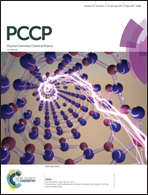Screening out unfeasible hypothetical zeolite structures via the closest non-adjacent O⋯O pairs†
Abstract
To boost function-led discovery of new zeolites with desired pores and properties, millions of hypothetical zeolite structures have been predicted via various computational approaches. It is now well accepted that most of these predicted structures are experimentally unrealisable under conventional synthetic conditions. Many structure evaluation criteria have been proposed to screen out unfeasible structures, among which the framework density–framework energy correlation criterion and the local interatomic distances criteria are the most frequently used. However, many hypothetical structures passing these criteria have been found unfeasible because of the existence of highly distorted framework rings. Here, we propose a new set of structure evaluation criteria to screen out such unfeasible structures. After optimising all existing zeolite structures as silica polymorphs, we find that the closest non-adjacent O⋯O distances in existing zeolite rings generally show a normal distribution. By comparing the closest non-adjacent O⋯O distances between existing and hypothetical zeolite structures, we are able to screen out many unfeasible hypothetical zeolite structures with distorted rings that are deemed feasible according to previous structure evaluation methods.



 Please wait while we load your content...
Please wait while we load your content...